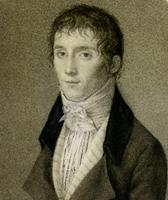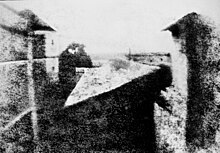Joseph Nicéphore Niépce
Joseph Niépce [ njɛps ] (born March 7, 1765 in Chalon-sur-Saône , † July 5, 1833 in Saint-Loup-de-Varennes ; called Nicéphore Niépce ) was a French inventor . He developed heliography , the world's first photographic technique . The first photograph that has survived to this day comes from him.
Life


Left: modern reproduction
Right: 1824 heliographically produced reproduction
Niépce, who had a sister and two brothers, was an officer in the French army from 1789 to 1811; between 1795 and 1801 he administered the district of Nice , then devoted himself to mechanical and chemical work in his hometown with his older brother Claude Niépce, and from 1815 to lithography . His photographic endeavors began in 1816, when he succeeded for the first time in temporarily capturing images from a camera obscura on chlorine silver paper , which, however, he was not yet able to fix.
In 1824 Niépce succeeded for the first time in not only copying an engraving by Cardinal Georges d'Amboise , but also in fixing it. However, this picture is not considered the first photo as it was not taken with a camera obscura. After further extensive experiments, in early autumn 1826 in Saint-Loup-de-Varennes, he took what was probably the world's first lightfast photograph: a view from the window of his study in the Le Gras estate with an exposure time of eight hours in 16.5 × format 21 cm. To do this, he used the camera obscura and, as a chemical substance, a coating of light-sensitive asphalt . This hardens when exposed to light and was developed with lavender oil . Niépce called his process heliography (from give a wiki. Ἥλιος , transkr. Helios = sun and γράφειν , transkr. Graphein = draw that map) and started in 1829 a correspondence with Louis Daguerre , to discuss the commercial feasibility of the invention and on new chemical processes .
Niépce died in Saint-Loup-de-Varennes about 7 km south of Chalon-sur-Saône in 1833, without having succeeded in exploiting his invention commercially. Niépce's work was continued by Daguerre and - independently of him - by his cousin Claude Félix Abel Niépce de Saint-Victor . Niépce's approach ultimately led to the development of the daguerreotype and thus to the market maturity of photography in 1839. However, it was only the negative-positive process developed by William Henry Fox Talbot that became sustainably established . The "niepçotype" ( heliography ) is still used as a fine printing process .
In honor of Niépce, the municipality of Saint-Loup-de-Varennes has renamed the street with his house in Rue Nicéphore Niépce . Nearby, outside the town limits, a monument to Niépce has been erected on Route nationale 6 (see photos). The city of Chalon-sur-Saône named the science high school Lycée technique Nicéphore-Niepce after him . The Musée de la photographie Nicéphore Niépce is located in Chalon-sur-Saône on the banks of the Saône at Quai des Messageries No. 28 . The Niépce Glacier in Antarctica also bears his name.
Surname
Joseph Niépce called himself Nicéphore Niépce from around 1787–1789 ; There are different theories about the origin of the nickname "Nicéphore" (derived from the Greek νίκη φορέας níki foréas "Siegesbringer" and a play on his surname) (nickname from school, battle name during the French Revolution).
photos
price
The Prix Niépce is a prize for photography of the Association Gens d'Images , established in honor of Joseph Nicéphore Niépce in 1955 and founded by Albert Plécy , which is awarded annually to a "professional photographer who has been in France for at least three years and is less than 45 years old" is awarded. In 2005, for example, the prize was awarded to Elina Brotherus and in 2008 to Jürgen Nefzger .
See also
literature
- Isidore Niepce: Post tenebras lux. Historique de la decouverte improprement nommée daguerreotype etc. Paris 1841
- Fouque: La vérité sur l'invention de la photography . Paris 1867
- Dr. Eder : Niépce or Niepce , in: Photographische Correspondenz , 19th year, Vienna and Leipzig 1882, pp. 157–159 ( online )
Web links
- Literature by and about Joseph Nicéphore Niépce in the catalog of the German National Library
- http://www.niepce.com/
- http://www.nicephore-niepce.com/
- http://www.museeniepce.com/ - Musée Nicéphore Niépce
- http://www.geog.ucsb.edu/~jeff/115a/history/niepce.html - Biography of Joseph Nicephore Niépce (English)
- http://www.hrc.utexas.edu/exhibitions/permanent/wfp/ - Heliography from 1826 in the Harry Ransom Center at the University of Texas at Austin
- A picture and its story: light and asphalt article in the star
- Film report: Reconstruction of the shooting position and invention of the first photograph on YouTube (French)
- Film report: Reconstruction of the shooting position and invention of the first photograph on YouTube (English)
- Exhibition in the Reiss-Engelhorn-Museum in Mannheim until January 6, 2013 "The hour of birth of photography"
- http://www.deutschlandfunk.de/joseph-nicephore-niepce-der-heimliche-erfinder-der.871.de.html?dram:article_id=313060 Calendar sheet Deutschlandfunk for the 250th birthday on March 8, 2015
Individual evidence
- ↑ Bien Public: Niépce
- ^ Daniel Girardin "Niépce versus Ste Véronique" in "Nicéphore Niépce, une nouvelle image", Société des amis du Musée Nicéphore Niépce, Chalon-sur-Saône, 1999.
- ↑ Prix Niépce ( Memento of the original from April 13, 2015 in the Internet Archive ) Info: The archive link was inserted automatically and has not yet been checked. Please check the original and archive link according to the instructions and then remove this notice.
| personal data | |
|---|---|
| SURNAME | Niépce, Joseph Nicéphore |
| ALTERNATIVE NAMES | Nièpce; Niepce |
| BRIEF DESCRIPTION | French co-inventor of photography |
| DATE OF BIRTH | March 7, 1765 |
| PLACE OF BIRTH | Chalon-sur-Saône |
| DATE OF DEATH | July 5, 1833 |
| Place of death | Saint-Loup-de-Varennes near Chalon-sur-Saône, France |





